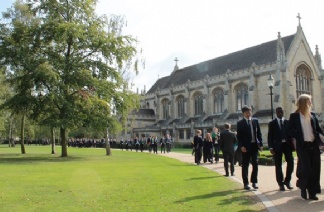Ex. 1
Instructions
Listening
Lecture scripts
While we often point out how humans benefit by cooperating with one another, we should also note that many animals act in concert, too. In fact, without cooperating with one another, many animals would be much less well off (处境好的,走运的) .
For example, many animals cooperate to 1) maximize their protection from predators while others work together in order to 2) locate and exploit new food sources.
Let’s think about deer first. With their antlers, you’d imagine they wouldn’t need any protection.
But what about does 母鹿, fawns 幼鹿, and older deer? Wolves and other predators can take down a deer easily, especially by hunting in packs. So what do deer do?
Well, one defensive measure they use is to feed in groups. This helps keep them safe from predators. How? Well, for one, they can alert one another more quickly when predators are nearby, which allows younger, older, or weaker deer to hide or escape.
Second, there’s safety in numbers. Predators are far more likely to attack a single animal than a large group of them.
Now, how about honeybees? They work together, too. You’ve heard of the honeybee’s dance, right?
That’s a textbook case of animal cooperation.
When looking for food, honeybees all head in different directions. When they find a potential food source, they return to the hive 蜂房. Then they perform a complicated dance, which scientists believe, actually gives the direction, distance, and amount of food located.
This allows the bees to abandon unpromising searches and move on to food sources that are closer and which will be able to provide more food for the hive.
Sample notes:
ani. Coop. :
safety: Eg. deer: feed 小组→ 离猎物
1) alert
2) pre. 不小组
food : Eg. bees: dance dif. 方向 、距离、量
1)closer
2) more
Question:
Speaking
Sample answer:
In the lecture, the professor tells us about two different activities animals engage in to cooperate with one another. She states that they work together either to maximize their protection from predators or to locate and exploit new food sources.
Then the professor gives two examples to further illustrate them. The first example is about deer. By feeding together, deer can alert one another quickly when predators come. This lets various young, old or sick deer hide while others stay close together to attempt to protect themselves from attackers. Furthermore, predators are less likely to attack a group.
The second is an example of honeybees. They go in different directions in search of food and, upon locating it, return to their hives to perform a dance. By doing this dance, they share their knowledge of the location, distance and amount of the food source with the other bees, which enables them better to provide for the needs of the entire hive.
Ex. 2
Instructions
Listening
Lecture scripts:
I’d like to point out something about art from the past. In previous eras, making art was expensive. Most artists required patrons 赞助人 merely to afford the paint, canvas, and everything else they needed, and these patrons, naturally, kept most of the artwork in their homes for their own personal viewing.
This made art inaccessible to most people. The artists, quite understandably, didn’t appreciate this, so they came up with two ways to enable the public to admire their work.
For one, many artists began 1) using cheaper materials. This let them work without a sponsor. This way, they could produce the art they wanted to and also retain possession of their art. They were then free to display it wherever they wanted to.
This, naturally, permitted many more people to see their work. Of course, one drawback to this approach was that the lower quality of the paint and other materials meant their work often faded quickly. Fortunately, many of these works can now be restored using modern methods.
Another thing artists did was to 2) display their art both outdoors and in public places. Remember that artists didn’t just do paintings. They did statues, sculptures and many other kinds of art. Take a look at any cathedral. There is art everywhere. Look at the statues and the stained glass window in them.
They’re all works of art. And consider one of the greatest examples of art anywhere---Michelangelo ’s 米开朗基罗 work in the Sistine 罗马教宗西克斯图斯的 Chapel 小礼拜堂. How many thousands of millions of people have seen his artwork? He attained what most artists strive for: for the greatest number of people to admire his work.
Sample notes:
public—art
cheaper materials - whatever-- 质低—现代技术--解决
display outdoors + public places
Question:
Speaking
Sample answer:
In the lecture, the professor tells about two methods artists used to make their work viewed by the public. One is to utilize cheaper materials; the other is to display their work outdoors or in some other public places.
Before, artists had to rely on patrons to support them financially. However, these patrons would keep the artists’ works for themselves. But by using cheaper materials, they were at liberty to display their work anywhere they wanted. (叙述型)
Though the low quality of the material might make the artwork fade quickly, the modern methods made it possible to stay in an excellent condition. (可省)
Another measure artists took to let the general public admire their works is to display it outdoors or in public places. She states that cathedrals are full of art like statues and stained glass window. She also mentions Michelangelo’s work in the Sistine Chapel. In her view, doing art like this enabled the greatest number of people to see the artists’ works.
Tips for Task 6:
熟悉考试流程,题目特点。
树立时间观念 (20”—60“ )
养成笔记习惯
训练连词组句的能力。
合理安排结构,同义表达
不要加入个人观点。
注意人称不复杂,就说 professor 即可, 即使说 he/she 也是很容易的,因为就一个人在讲话。
T3 vs T4 T5 vs T6 T3 vs T5 T4 vs T6
Tips for Task 3-6
准确性:对阅读和听力的内容把握准确
完整性:覆盖主要的信息点(1+2)
客观性:遵从原文,不加人个人观点(T5 除外)
简洁性:语言尽量精炼,尤其在陈述例子时

















